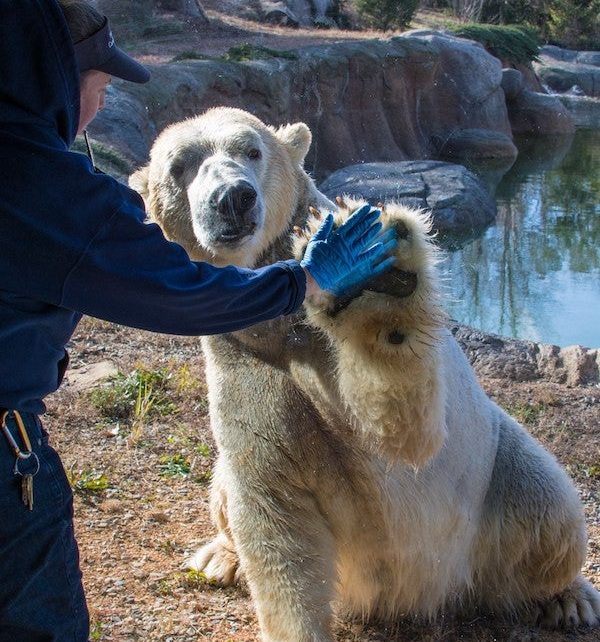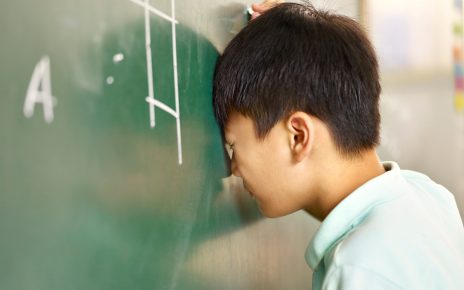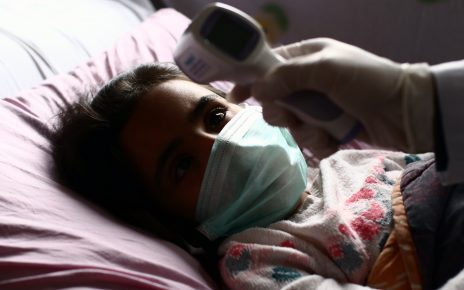Prior to the COVID-19 pandemic, the term “social distancing” was completely unfamiliar to most of us. Now we do our best to stay apart in order to slow the spread of the coronavirus. For those of us who work at zoos, however, it isn’t just humans we’re trying to protect. With a positive coronavirus diagnosis of a tiger at the Bronx Zoo in April, it quickly became clear that other mammals might also be susceptible.
As a result, the staff at the North Carolina Zoo, where we work, have had to social distance, not only from each other, but from their animals as well. Just as with people, this means staying six feet away where possible and wearing masks. Veterinary staff have canceled some elective medical procedures, such as annual exams. Keepers have had to limit training sessions to the most critical behaviors necessary to complete veterinary procedures (like getting chimpanzees comfortable with presenting their arms for blood draws, for example).
Many of our caregivers have worked with the same animals for years, sometimes even decades. Just as the virus has torn many of us from our close family and friends, animals who are closely bonded with their keepers have had to adjust to the new normal of social distancing. They have also had to adjust to the faces of masked keepers. As those of us with small children know, wearing a mask can be a bit intimidating at first. It changes how you look, and makes it difficult to express yourself. As an example, this has added a new learning curve to the training sessions for our sea lions, as they rely on subtle cues from a keeper’s facial expression. With this no longer being an option, the animals have had to recalibrate how they interact with their humans (and they’re doing a great job at it!).
These changes go beyond the relationships between the staff and animals; animals all over the world are experiencing a zoo devoid of visitors—many, for the first time in their lifetimes. Some, like our gopher frogs and pine snakes, seem to be enjoying the break from all the gawking eyes. Our polar bears even seem to be taking advantage of the lack of visitors and getting some extra shut-eye.
But others seem to be missing all the attention. For animals that act as ambassadors, frequently engaging with the public, life in shutdown can be particularly challenging. The Maryland Zoo’s macaw and African grey parrot have been protesting the lack of handlers (which can be up to 15 people a day) by screaming or calling names to get the staff’s attention. Sally Adams, one of North Carolina Zoo’s animal management supervisors, noted that the sea lions and seals “seem to have the biggest reaction of all. The sea lions are extremely social animals and had gotten used to seeing people every day. Now that they are not, they tend to gravitate to the windows when anyone walks by. They follow from window to window…. Their curiosity gets the best of them and they start porpoising or push their faces right up against the glass to look at us.” Keepers have been advised to simply stop and just watch their animals, to ensure daily human interaction and mental stimulation. After all, when you visit a zoo, you aren’t just observing the animals; they like to watch you too.
So, what to do at a zoo with no visitors? Zoos around the world have had to get creative to figure out how to keep their charges engaged. The Oregon Zoo has relied on taking their more docile animals for walks, to visit other species that can’t go out. For instance, the park’s porcupine, Nolina, visited the zoo’s giraffe and monkey habitats, providing entertainment on both sides of the glass. A Humboldt penguin, Nacho, was brought to meet the seals.
At the Fort Worth Zoo, a Patagonian mara, an odd rodent that looks slightly like a deer, paid a surprise visit to three otters. Tokyo’s Sumida Aquarium had noticed that its spotted garden eels were getting a bit shy and disappearing into their burrows when staff passed by, making it difficult to keep an eye on their health. So the aquarium is now asking the public to video chat with the eels to remind them of the existence of humans and keep them used to surfacing when people are around. At Boston’s Franklin Park Zoo, keepers have set out automated bubble machines to continuously entertain the otters and gibbons while the staff scramble to attend to their daily duties.
And here at the North Carolina Zoo, our chimpanzees were delighted when they recently got a visit from the turtles. Our keepers are also finding innovative ways to train from a distance. Keepers stand on rooftops to work with the polar bears; across fences to interact with the arctic foxes; and across the public viewing area (our “overlook”) to keep an eye on the pinnipeds—the seals and sea lions. These novel solutions allow both the animals and their human caretakers to maintain their strong social bonds with each other during this unusual time, keeping the animals actively engaged during the day despite the lack of normal spectators.
Social distancing isn’t easy for anyone, but it is critical to keep us healthy and to keep our animals safe. And despite the challenges and changes we’re facing, some things remain the same. The animals at North Carolina Zoo are still getting the best care possible as our dedicated staff continue to feed, clean and care for them.
Read more about the coronavirus outbreak from Scientific American here, and read coverage from our international network of magazines here.




